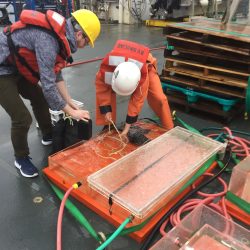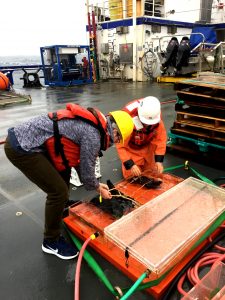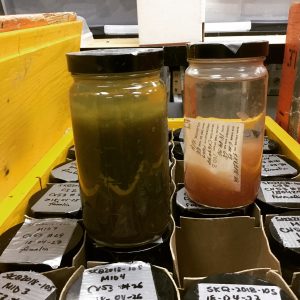
Research Experience for Undergraduates
The ideas for REU projects give an overview of currently interesting research topics at the NGA LTER. They range from physics to chemistry to biology. They involve retrospective analysis of decades worth of data or cutting-edge sampling aboard R/V Sikuliaq. The following are project ideas submitted by UAF investigators. REU students might work one of them, or use them as inspiration to design their own summer project. At the end of the summer, students will present their findings.
REU project with Seth Danielson:
The physics of the Prince William Sound
Prince William Sound (PWS) is a fjord adjacent to the Gulf of Alaska. A shallow sill separates the deep waters within the fjord from the Gulf, which provides sheltered habitat for zooplankton that over-winter there during diapause. Since the Exxon Valdez oil spill, physical oceanographic measurements, such as temperature and salinity, have been taken in PWS. The REU student will assemble these measurements (and the density calculated from them) from multiple sources, and will compute monthly means and time-series of anomalies. Consequently, we can investigate:
- Do the deep waters in PWS get replaced every year?
- Are there trends in the temperature and salinity properties?
- How much do the deep properties vary from one year to the next?
The student will gain experience analyzing physical oceanographic data, and will code algorithms in either MATLAB or Python.

REU project with Ana Aguilar-Islas:
Investigating nutrient cycling in the Northern Gulf of Alaska (NGA)
Along with light, nutrients are essential resources for phytoplankton (unicellular primary producers). In the NGA, the relative availability of macronutrients (i.e., nitrate, phosphate, silicic acid) and the micronutrient iron exert a key control on the phytoplankton community structure, which in turn influences higher trophic level communities.
The REU student will participate in the summer 2019 LTER cruise onboard R/V Sikuliaq in late June/early July. Onboard, they will:
- Participate in water sampling while collecting macronutrients, and
- Help perform iron dissolution experiments.
Back in the lab, the student will work with archived nutrient data to investigate inter-annual (2017 and 2018) and seasonal (spring and fall) variability in macronutrient distributions along the Seward Line in the NGA. The student will gain seagoing experience, will learn best-practices in the collection of seawater for nutrient analysis, will gain experience plotting and interpreting oceanographic chemical data.

REU project with Russ Hopcroft:
Computers help count zooplankton
NGA-LTER scientists collect millions of zooplankton during our net tows in the Gulf of Alaska. These must be identified into species and counted to order to understand the Gulf’s community structure. But that is tedious work. Therefore, we are teaching computers to do it for us. First, a watertight, flat-bed scanner (ZooScan) creates a digital image of a plankton sample from a net tow. Then software isolates individual images and sorts them into taxonomic groups (or particles and detritus). To teach the software how to do the sorting, scientists create a training set and then double-check the output. The REU student will gain lab experience as they scan and sort samples, and then will have the opportunity to look for differences in communities across stations and cruises.
REU project with Russ Hopcroft:
Telling sisters apart
The Gulf of Alaska zooplankton contains many examples of closely related “sibling species”. These species occupy similar niches in the environment, but are slightly different in ways that may create advantages under changing conditions. It is likely that climate change acts by tipping the scales on which sister species are more successful. Unfortunately, zooplankton sampling in previous years did not always differentiate between these sisters. To gain knowledge about how things have changed in the NGA over the years, we hope a detail-oriented REU student will look back through our archived samples. They will help establish the shifting ratio of two keystone copepod species during the first decade of our time series, while they gain experience in microscope work and taxonomic classification. Moreover, we are also open to other small projects that might utilize our historical samples.

